Ever found yourself a bit lost during a hike, misplaced by Mother Nature herself and questioning the route ahead? Though it can be unnerving, you’re not alone. I’ve spent countless hours pouring over maps and researching natural landmarks to combat disorientation in the wilderness.
Let this blog serve as your personal guide, offering nine practical tips for identifying key natural landmarks while hiking so you can navigate your way confidently and safely. Ready to embrace those trails with newfound courage?
Key Takeaways
- Research the hiking area before you go to learn about the trail difficulty, length, and terrain.
- Map out your hike by checking trail maps, noting parking spots and restrooms, and considering who you will hike with.
- Learn to identify and understand natural landmarks like mountains, waterfalls, and forests to navigate your way on the trail.
- Have proper footwear, lightweight clothing for changing weather conditions, navigation tools like maps or GPS devices, and a hydration plan for a successful hiking trip.
Importance of Planning and Preparation
Research the hiking area, determine the difficulty level, and map out your plan before hitting the trails.
Research the hiking area
Before you go hiking, it’s smart to learn about the area. This step is key in your planning process. Start by picking the right trail for you. Look at maps and read brochures to find out how long and hard the hike will be.
You should also check if there are big changes in height along the way and what kind of ground you’ll be walking on. It’s good to know if there will be a place for your car when you get there, and if restrooms are close by, too.
Don’t plan to hike alone – having friends with you can make the trip safer and more fun. All this prep work can help ensure that your hike goes well from start to finish!
Determine the difficulty level
In planning a hike, the trail’s level plays a big role. It can shake or make your trek. So, I look at its difficulty rating first. This helps me pick a route that fits my fitness level and hiking limits.
Next comes the terrain type and how much it goes up or down. A flat walk in a park would be easy, right? But add some hills and uneven ground – now it becomes moderate to tough!
Map out your plan
Planning out your hike is key to a successful adventure. It’s the first step before setting foot on a trail.
- Start by checking out trail maps or brochures. This will give you clear insights on length, difficulty level, elevation, and terrain.
- Note down any parking spots near your chosen trail. This makes it easy to find a place for your car.
- Look for restroom facilities along or near your route. It’s good to know their locations in advance.
- Think about who you’re hiking with. Having companions can add fun and safety to your hike.
- Build up self – reliance skills before hitting the trails. This may include map reading or first aid basics.
- Always make good choices while hiking. If a path seems too risky, take an easier route.
- Lastly, consider the weather if you’re planning a multi – day trek. Pack gear that can handle rain, wind, or cold.
Identifying and Understanding Natural Landmarks While Hiking
When hiking, it’s important to be able to identify and understand natural landmarks along the trail. These landmarks can include mountains, caves, waterfalls, valleys, canyons, cliffs, lakes, forests, trails, and wilderness areas.
Recognizing these features can help hikers navigate their way and stay on track during their hike. By studying maps and using reference points like these natural landmarks as guideposts, hikers can easily find their location and stay on the right path.
This is especially crucial for self-navigation while hiking in unfamiliar terrain. Therefore, it’s essential to have a good understanding of the natural landmarks you may encounter on your hike so that you can confidently explore the great outdoors.
Essential Gear and Supplies
Proper footwear, lightweight clothing, navigation tools, and a hydration plan are crucial for a successful hiking trip. Don’t forget these essentials! Read on to learn more about the must-have gear and supplies for your next adventure.
Proper footwear
When it comes to hiking, having proper footwear is essential. Investing in quality leather hiking boots can be a wise decision in the long run. These boots can last for years if taken care of properly.
It’s important to replace the sole when needed, as worn-out soles can decrease traction and support on the trail. When choosing shoes or boots for hiking, consider factors like traction, support, and protection.
Well-fitting footwear that provides these features will help keep you comfortable and safe during your hikes. Whether you prefer hiking boots or shoes depends on your personal preferences and needs.
Lightweight and weather-appropriate clothing
When hiking, it is important to wear lightweight and weather-appropriate clothing. Dressing in layers allows you to adjust your attire based on changing weather conditions and the intensity of your activity.
Look for moisture-wicking fabrics that will keep you dry and comfortable as you sweat. Carrying a warm hat is also recommended, as heat can escape from the head during colder temperatures.
Additionally, it is essential to have a waterproof rain jacket with a hood in case of unexpected rain showers. Choose breathable materials that allow air circulation and help wick away sweat.
Navigation tools
When it comes to hiking, having the right navigation tools is crucial. Maps and compasses are important for finding your way on the trail. You can also use navigational apps or GPS units to help you stay on track.
Gaia GPS is a popular tool for self-navigation while hiking. It’s important to learn map and compass skills as well as environmental navigation techniques. These tools will ensure that you can navigate safely and confidently while exploring natural landmarks on your hike.
Remember, map and compass/GPS are considered essential navigation tools for hikers according to the Ten Essentials of Hiking.
Hydration plan
Staying hydrated is important when hiking. Here is a plan to help you stay hydrated:
- Start hydrating before your hike: Begin drinking water or electrolyte-infused beverages a day or two before your hike to ensure that your body is well-hydrated.
- Carry ample water supply: Bring enough water to last for the duration of your hike. It’s better to have more than less, especially if you’re unsure about the availability of clean water sources along the trail.
- Consider water treatment techniques: If you anticipate needing to refill your water along the way, it’s essential to know how to treat it properly. Research and carry the necessary tools or methods for purifying water such as filtration systems or iodine tablets.
- Avoid common hydration mistakes: Remember to drink continuously throughout your hike, even if you don’t feel thirsty. Ignoring thirst cues can lead to dehydration, which can negatively affect your performance and overall well-being.
- Develop a proper hydration strategy: Take regular sips of water rather than chugging large amounts at once. This helps with absorption and prevents discomfort caused by drinking too much at once.
- Hydrate during breaks or rest stops: Use these moments to sip on water and replenish fluids lost through sweat. Pay attention to signs of dehydration like dizziness, fatigue, or dark-colored urine and take action immediately if any symptoms appear.
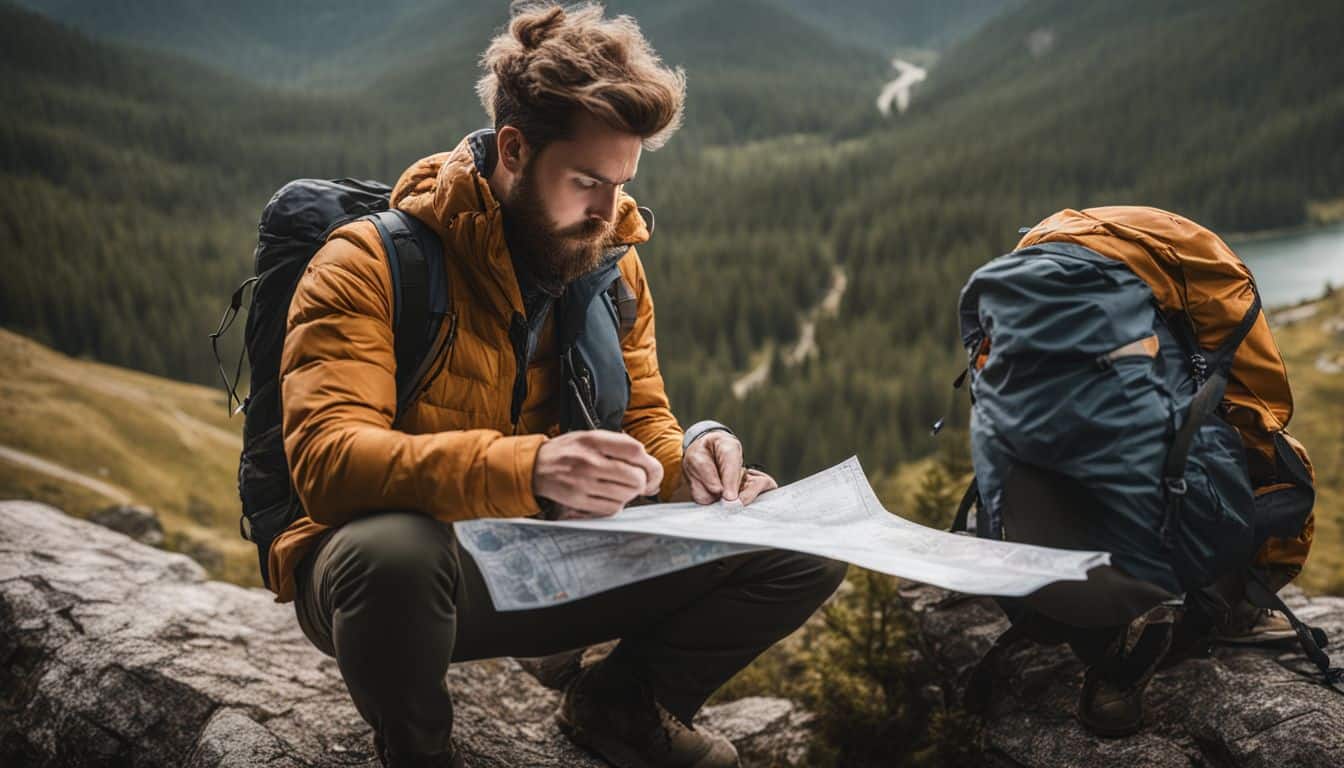
Safety Measures
Take the necessary precautions by informing a friend or family member about your hiking plans, bringing emergency gear, and always being aware of your surroundings.
Tell a friend or family member about your hiking plans
It’s important to let someone know about your hiking plans before you go. Share your itinerary with a friend or family member, including details like the trail you’ll be hiking, starting and ending points, and estimated duration.
This way, if anything unexpected happens while you’re out on the trail, someone will have an idea of where to find you or when to expect your return. It’s always better to have someone looking out for you in case of emergencies.
Plus, it can also add some peace of mind knowing that someone is aware of your plans and can check in on you afterwards. So remember, before hitting the trails, share your hiking plans with a loved one!
Bring emergency gear
I always make sure to bring emergency gear when I go hiking. It’s important to be prepared for any situation that may arise. Here are some essential items to include in your hiking pack:
- Survival kit: Pack a small survival kit with items like a knife, whistle, and waterproof matches. These can come in handy in emergency situations.
- Compass navigation: A compass is a crucial tool for navigating through unfamiliar terrain. Make sure you know how to use it properly.
- Fire starting tools: Carry fire starters or waterproof matches so you can quickly start a fire if needed for warmth or cooking.
- GPS tracking device: In case you get lost, a GPS device can help rescuers locate your exact position.
- Portable light source: A headlamp or flashlight is essential for navigating in low-light conditions or during emergencies.
Pay attention to your surroundings
While hiking, it’s really important to pay attention to your surroundings. Always keep an eye out for trail markers and stick to designated paths. Don’t forget to take note of landmarks along the way and check your map frequently, even if the trail seems obvious.
Being aware of your environment can help you stay safe and avoid potential hazards. Remember to watch your footing and stay cautious while enjoying the beauty of nature around you.
So, prioritize safety by staying alert and orienting yourself to your surroundings while hiking.
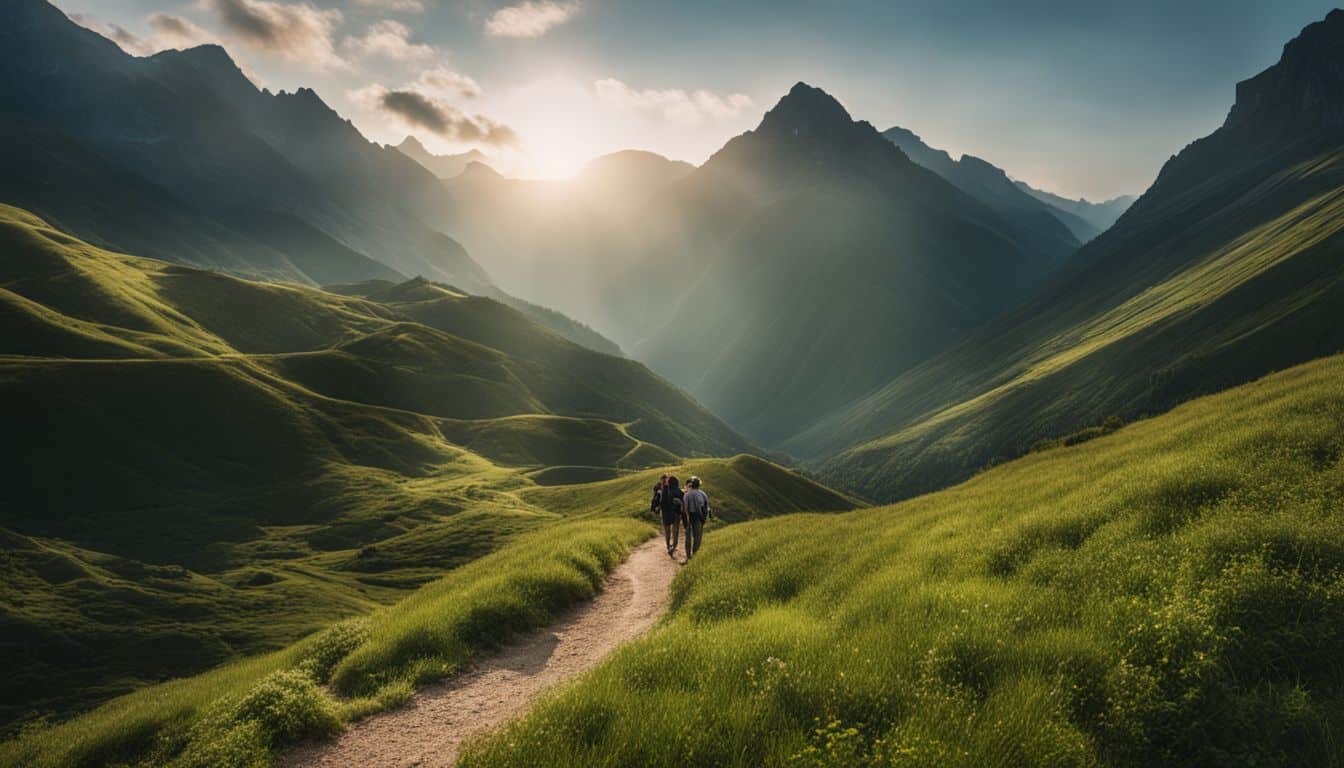
Landmarks and Points of Interest
Note significant landmarks along the trail and explore hidden gems like serene lakes, picturesque waterfalls, and breathtaking landscapes. Keep reading to discover more natural wonders you can encounter while hiking!
Note significant landmarks along the trail
As a hiking enthusiast, it’s important to pay attention to the notable landmarks and locations along the trail. These spots can help you navigate and track your progress as you hike.
By noting these significant landmarks on your map or in your guidebook, you can have a better understanding of where you are and what lies ahead. It could be a breathtaking waterfall, an impressive rock formation, or even a beautiful meadow.
Remembering and recognizing these distinctive features will make your hiking experience more enjoyable and memorable. So keep an eye out for those special spots that make each trail unique!
Research natural landmarks to look for
I love hiking and exploring the great outdoors. When I go on a hike, I always make sure to research the natural landmarks that I can look for along the way. It adds an extra element of excitement and makes the hike even more enjoyable. Here are some tips for researching natural landmarks:
- Check online: Look for websites or blogs that provide information on hiking trails and the natural landmarks you may encounter. You can find detailed descriptions, photos, and even maps to guide you.
- Ask local experts: Reach out to local nature centers, park rangers, or hiking clubs in the area. They often have insider knowledge about hidden gems and unique features of the landscape.
- Join online communities: There are many online forums and social media groups dedicated to hiking and outdoor enthusiasts. Joining these communities can give you access to valuable information from experienced hikers who have already explored the area.
- Read guidebooks: Guidebooks specifically tailored to hiking in certain regions often contain detailed information about natural landmarks along the trails. These books are a great resource for learning about what you might see on your hike.
- Attend nature programs: Many parks offer guided hikes or nature programs led by knowledgeable guides who can help identify and explain the natural landmarks you encounter during your hike.
- Use smartphone apps: There are several apps available that provide information about hiking trails and points of interest along those trails. These apps can enhance your hiking experience by giving you real-time information while on the trail.
- Visit visitor centers: If there is a visitor center near your chosen hiking trail, make sure to stop by before starting your hike. They often have maps, brochures, and knowledgeable staff who can provide valuable information about the natural landmarks in the area.
Environmental Responsibility
Pack out what you pack in, respect wildlife and their habitats, and leave no trace. Learn how to preserve nature while enjoying the beauty of the outdoors.
Pack out what you pack in
One of the most important things to remember while hiking is to pack out any trash or waste that you bring with you. This means that everything you bring in should be brought back out, including food wrappers, water bottles, and even orange peels and banana peels.
Leaving behind trash can harm the environment and disrupt the natural habitat of plants and animals. By packing out what you pack in, we can help preserve the beauty of our natural landmarks for future generations to enjoy.
Remember to always practice good environmental stewardship and leave no trace behind on your hikes.
Respect wildlife and their habitats
When hiking, it’s important to respect wildlife and their habitats. We can show respect by observing animals from a distance and not getting too close or following them. Feeding wildlife may seem harmless, but it can actually harm their health and disrupt their natural behaviors, so it’s best to avoid feeding them.
It’s also essential to stay informed about wildlife and their habitats so that we can better understand how to protect and respect them. If you’re taking photos of wildlife, make sure to do so without disturbing or harming the animals.
Lastly, remember not to honk at wildlife as this can cause harm or stress for them. Let’s be responsible hikers who appreciate nature while preserving the well-being of our furry friends!
Leave no trace
One important aspect of responsible hiking is to leave no trace behind. This means preserving the natural environment by minimizing our impact on it. By following the principles of Leave No Trace, we can ensure that future hikers can also enjoy the beauty and serenity of these natural landmarks.
Staying on designated trails helps protect vegetation from getting trampled and prevents erosion. It’s also crucial to pack out whatever we bring in, respecting the wilderness and keeping it free from litter.
Additionally, being mindful of wildlife habitats and giving them space ensures their well-being. Let’s be stewards of the outdoors and practice low-impact recreation to conserve these beautiful landscapes for generations to come.
Physical Preparation
Train your body and build endurance before embarking on a long hike, gradually increasing the intensity of your workouts to improve strength and stamina.
Train and condition your body
To enjoy hiking to the fullest, it’s important to train and prepare your body. Here are some tips:
- Start an exercise regimen: Incorporate outdoor activities into your routine, like walking or biking, to increase your stamina.
- Focus on cardiovascular health: Engage in activities that get your heart pumping, such as running or swimming, to build endurance.
- Include strength training: Lift weights or do bodyweight exercises to strengthen your muscles and improve your overall fitness.
- Pay attention to diet and nutrition: Eat a balanced diet with plenty of fruits, vegetables, lean proteins, and whole grains to fuel your body for hiking.
- Take care of mental preparation: Prepare yourself mentally for the physical and mental challenges you may face while hiking. Stay positive and motivated.
Listen to your body and honor its limits
When hiking, it’s important to listen to your body and honor its limits. Pay attention to how you’re feeling physically and mentally throughout the hike. If you start to feel tired or in pain, take a break and rest.
Pushing yourself too hard can lead to exhaustion or injury. Remember the importance of physical preparation before embarking on a hike, as it helps build endurance, muscle strength, and flexibility.
Rest and recovery are equally important for preventing injuries and allowing your body time to recover. Stay hydrated by drinking water regularly during your hike and make sure you have a proper warm-up session before starting your trek.
Hydration and Nutrition
Stay hydrated during your hike by bringing plenty of water and electrolyte-rich drinks, as well as planning meals and snacks that provide sustained energy for your journey.
Stay hydrated during the hike
Staying hydrated is really important when you’re hiking. Make sure to drink water regularly, even if you don’t feel thirsty yet. It’s best not to wait until you’re thirsty because that means you might already be dehydrated.
Carry enough water with you so that you have plenty to drink throughout the hike, especially if it ends up taking longer than expected. Dehydration can cause dizziness, confusion, and dark-colored urine, so it’s a good idea to stay hydrated to prevent these symptoms.
Plus, being properly hydrated can help prevent muscle cramps and heat exhaustion too. So remember to drink up!
Plan meals and snacks for sustained energy
Planning meals and snacks is crucial for maintaining energy levels while hiking. Here are some tips to help you stay fueled during your outdoor adventure:
- Pack nutritious food: Choose foods that provide a good balance of protein, carbohydrates, and healthy fats. This can include trail mix, granola bars, jerky, nut butter sandwiches, and fresh fruit.
- Consider perishable foods: If you’re going on a shorter hike or have access to a cooler, you can pack perishable items like sandwiches or wraps with fillings such as lean meat, cheese, and vegetables. Ensure they stay fresh by using ice packs or keeping them in a chilled compartment.
- Opt for lightweight options: Look for lightweight and easy-to-carry snacks like energy bars or single-serving packets of nuts or dried fruits. These will provide a quick boost without weighing you down.
- Stay hydrated: Don’t forget to bring plenty of water or other hydrating drinks to keep yourself well-hydrated throughout the hike. Dehydration can negatively impact energy levels and overall performance.
- Plan for regular refueling breaks: Schedule breaks during your hike to rest and refuel. Use this time to have a snack or meal to replenish your energy stores.
- Include energy-boosting foods: Incorporate foods that are known for their energizing properties such as bananas (rich in potassium), whole grains (complex carbohydrates), and nuts/seeds (healthy fats).
- Avoid sugary snacks: While it may be tempting to reach for sugary treats for quick energy, they often lead to crashes later on. Instead, choose snacks with natural sugars like dried fruit or opt for alternatives like honey or agave nectar.
Sun and Weather Protection
Wear sunscreen to protect your skin from harmful UV rays and pack lightweight, protective clothing for changing weather conditions.
Wear sunscreen and protective clothing
As a hiking enthusiast, protecting yourself from the sun is crucial for a safe and enjoyable experience. Remember to wear sunscreen with high SPF (sun protection factor) to shield your skin from harmful UV rays.
Apply it regularly throughout your hike, especially if you’re sweating or in direct sunlight. Additionally, don’t forget to wear protective clothing like a broad-brimmed hat and sunglasses to shield your face from the sun’s rays.
Wearing lightweight and breathable long-sleeved shirts and pants made of sun-protective fabric can also provide extra defense against UV exposure. Taking these simple steps will help keep you comfortable and protected while enjoying the great outdoors!
Bring layers for changing weather conditions
Dressing in layers is important for adjusting to changing weather conditions while hiking. It helps you stay comfortable and protected throughout your journey. Here are some tips for bringing the right layers:
- Moisture-wicking items: Choose clothing made of moisture-wicking fabrics to keep sweat away from your body and prevent discomfort.
- Lightweight and breathable shirt: Wear a lightweight, breathable shirt as your base layer. This will help regulate your body temperature and keep you cool.
- Insulating mid-layer: Pack an insulating mid-layer, like a fleece jacket or vest, to provide warmth when temperatures drop.
- Waterproof outer layer: Carry a waterproof or water-resistant jacket that can protect you from rain or wind.
- Long pants or convertible pants: Opt for long pants or convertible pants that can be transformed into shorts if needed. This provides flexibility in different weather conditions.
- Warm hat: Bring a warm hat to keep your head protected from cold winds or sudden temperature changes.
Conclusion on Natural Landmarks To Look For While Hiking
In conclusion, by following these 9 tips for hiking success and paying attention to natural landmarks while on the trail, you can enhance your hiking experience. The importance of planning, preparing essential gear, practicing safety measures, and being environmentally responsible cannot be emphasized enough.
So lace up your boots, hit the trails, and enjoy the beauty of nature while staying safe and prepared. Happy hiking!
FAQs on Natural Landmarks To Look For While Hiking
1. What are some natural landmarks to look for while hiking?
Some natural landmarks to look for while hiking include waterfalls, rock formations, scenic viewpoints, wildlife habitats, and unique plant life.
2. How can I successfully navigate a hiking trail?
To successfully navigate a hiking trail, it’s important to study the trail map beforehand, follow markers or signs along the way, stay on designated paths, and use a compass or GPS if needed.
3. What should I bring with me when going on a hike?
When going on a hike, it’s important to bring essentials such as water, snacks or meals, proper footwear and clothing suitable for the weather conditions, sun protection (like sunscreen and hats), insect repellent, first aid kit and navigation tools.
4. Are there any safety precautions I should take while hiking?
Yes! Some safety precautions you should take while hiking include informing someone about your hike plans and expected return time; staying hydrated; being aware of your surroundings; watching out for slippery surfaces or steep edges; avoiding unfamiliar plants or animals that may be harmful; adhering to park rules; and respecting nature by not littering or damaging natural features.
5. Can I bring my pet with me when hiking?
It depends on the specific hiking trail regulations – some trails allow pets on-leash while others do not permit pets at all. It’s best to check with the park authorities before bringing your pet along for a hike.

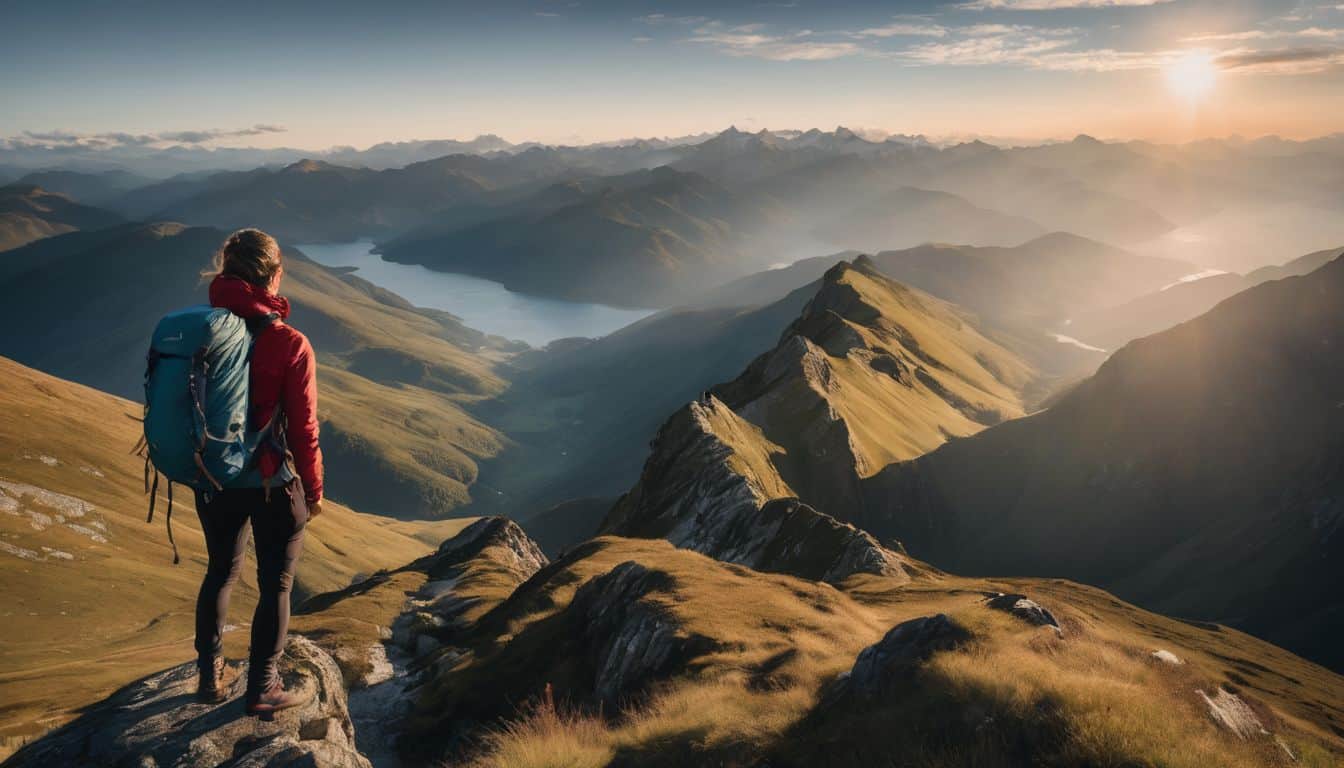
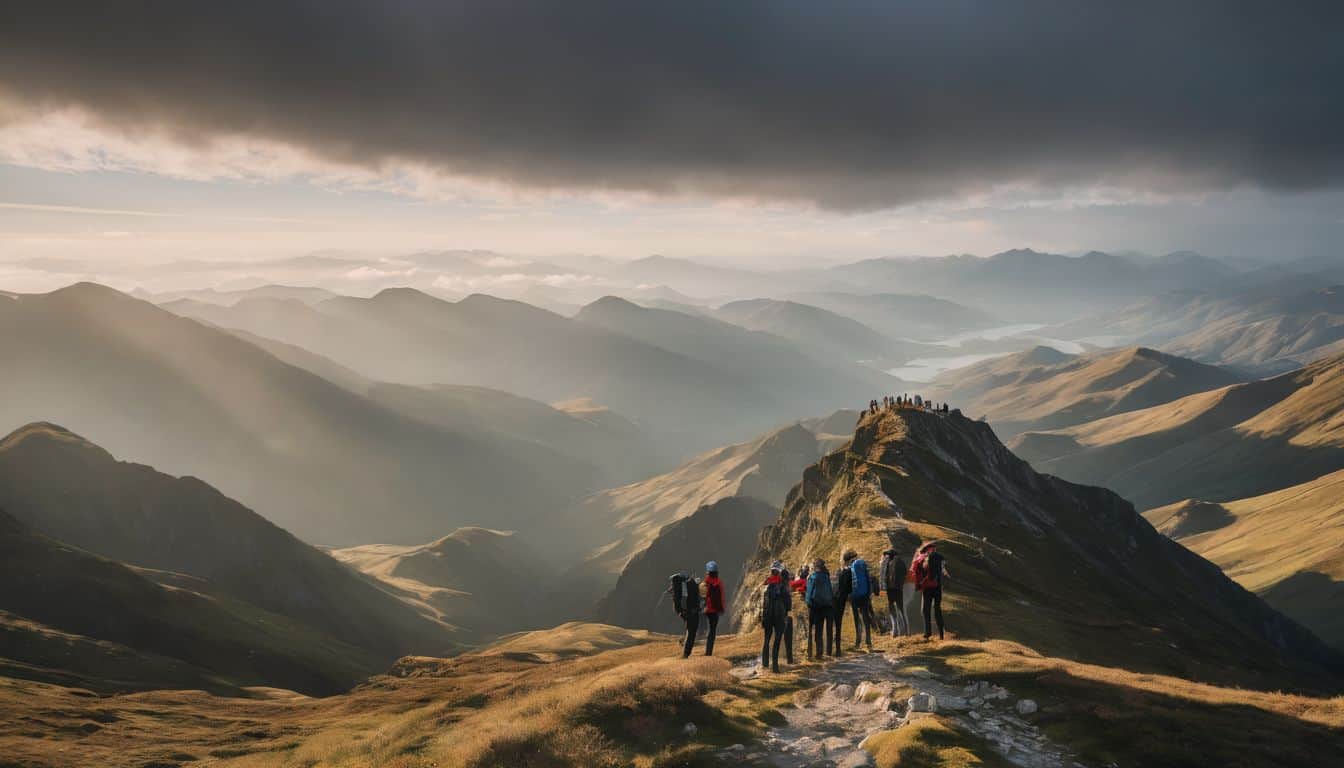
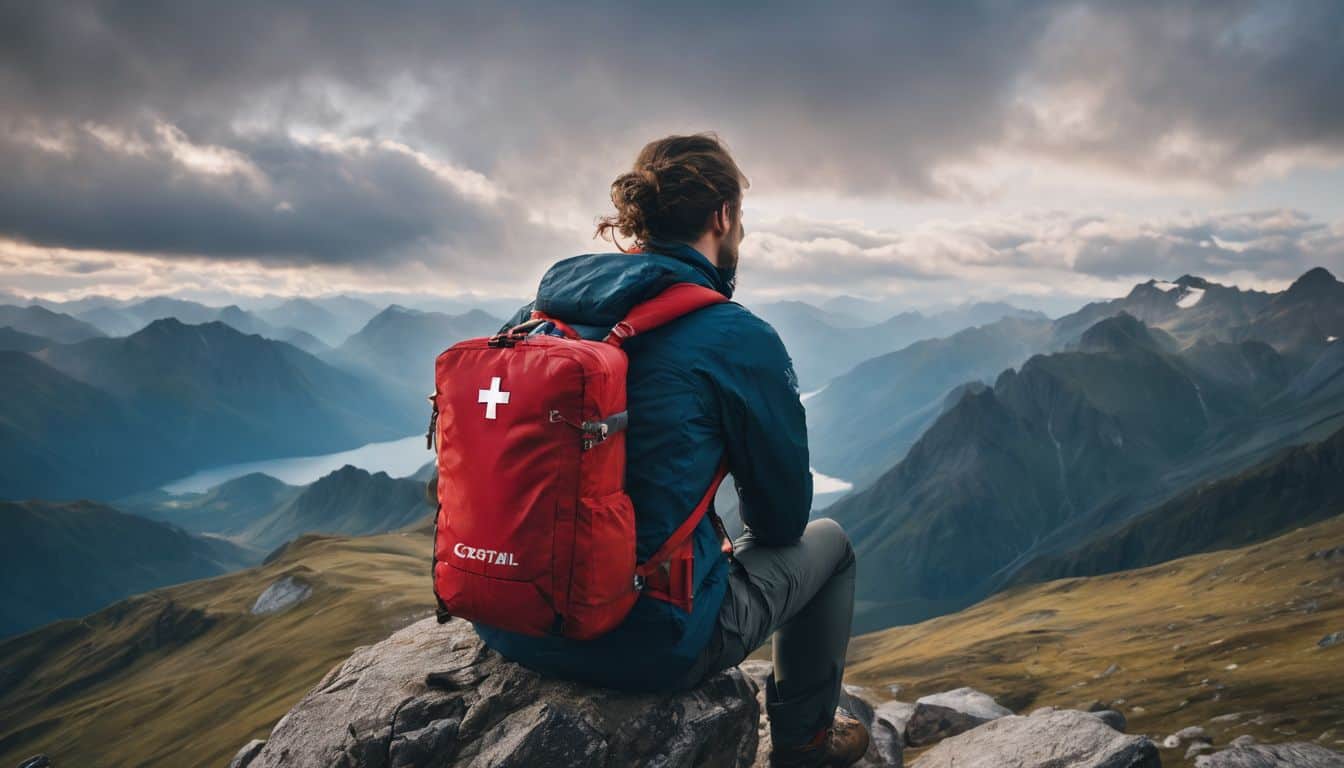
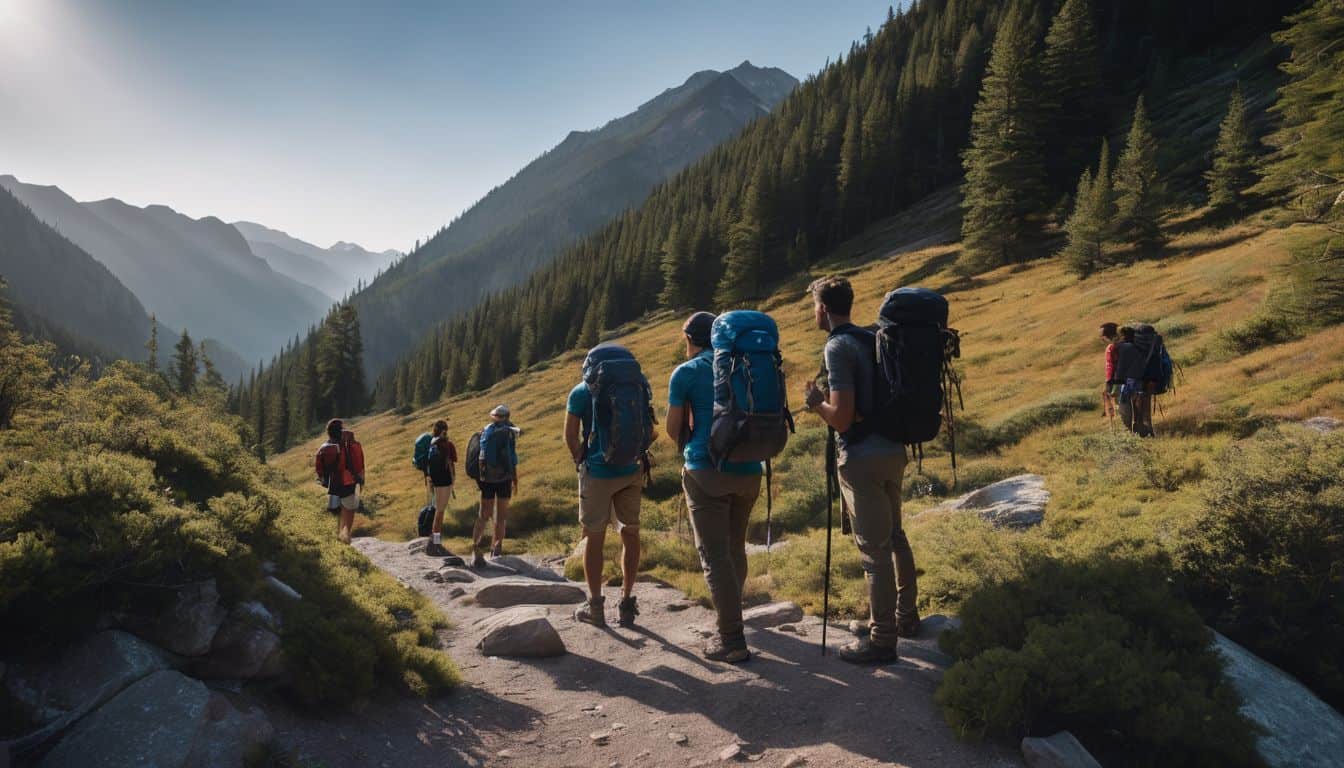
Leave a Reply